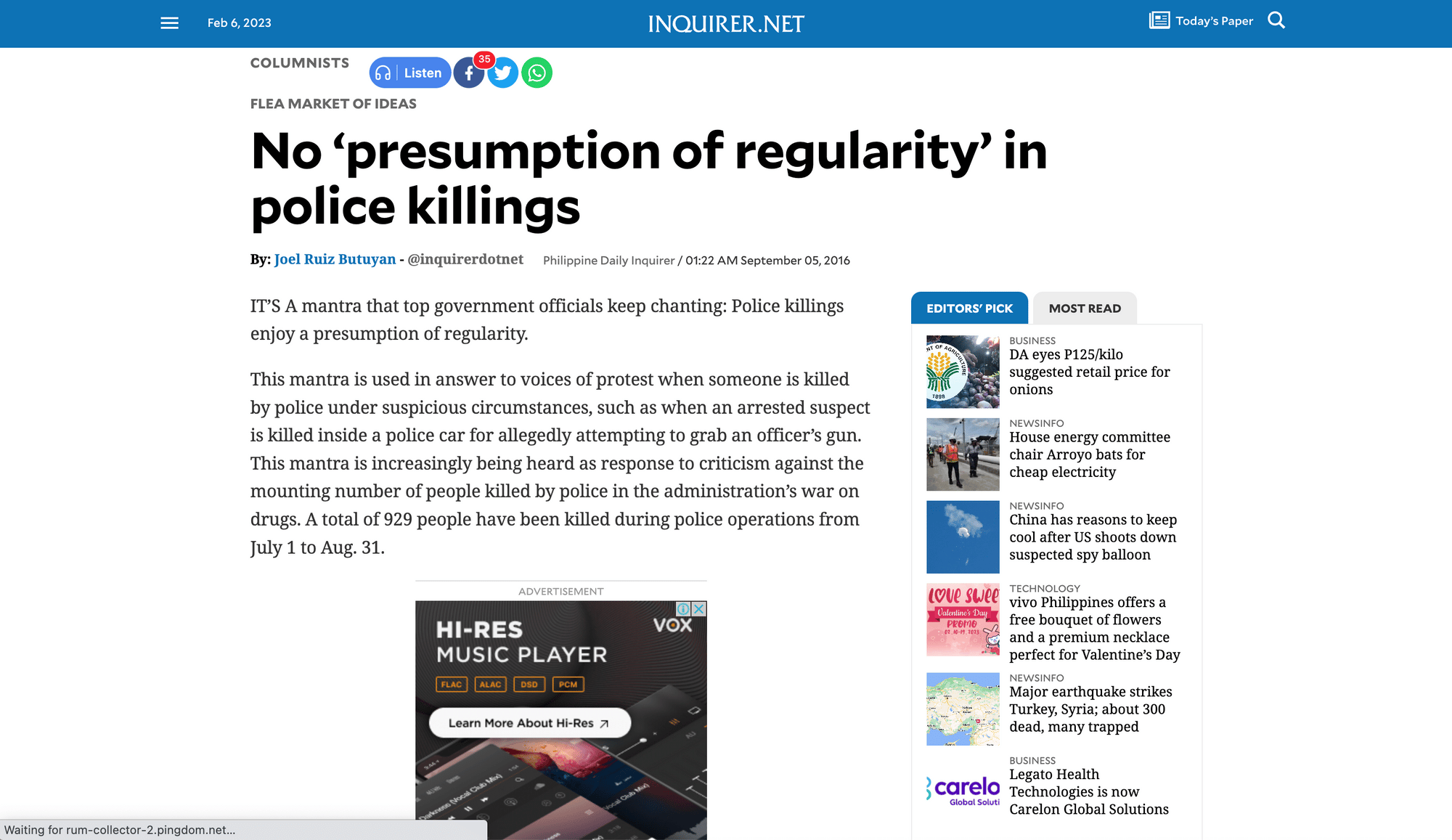IT’S A mantra that top government officials keep chanting: Police killings enjoy a presumption of regularity.
This mantra is used in answer to voices of protest when someone is killed by police under suspicious circumstances, such as when an arrested suspect is killed inside a police car for allegedly attempting to grab an officer’s gun. This mantra is increasingly being heard as response to criticism against the mounting number of people killed by police in the administration’s war on drugs. A total of 929 people have been killed during police operations from July 1 to Aug. 31.
President Duterte has repeatedly invoked this presumption while defending police killings. Even Philippine National Police chief Ronald dela Rosa, Solicitor General Jose Calida, and Sen. Panfilo Lacson vouch for its validity.
There is a presumption of regularity in the performance of government functions in general, but this presumption does not apply to police killings.
The general rule is that policemen only have the power of arrest. And policemen can essentially use the power of arrest in only two instances: 1) when a court has issued a warrant of arrest, and 2) when a person commits a crime in the presence of the police (warrantless arrest).
Even when a suspect resists arrest, policemen do not automatically have the power to kill the suspect. In such a scenario, the duty of policemen is to use reasonable force in order to subdue and take the (living) suspect into custody.
It is when the resistance employed by the suspect poses “imminent danger” to the life of a policeman or any other person that an exception to the power of arrest arises.
When there is imminent danger to any human life, policemen will be empowered to use deadly force even to the extent of killing the suspect. The imminent danger to human life is called a “justifying circumstance” (of self-defense, or defense of a stranger) that makes the killing lawful.
Is the existence of a justifying circumstance presumed in police killings?
The Supreme Court has ruled that a justifying circumstance is not presumed in police killings. Policemen who kill a suspect have the burden of proving the existence of such a circumstance.
One relevant ruling of the Supreme Court was issued in 2013 in Aguilar vs Department of Justice et al. (G.R. No. 197522). This case involved police and military personnel who arrested Francisco Aguilar for alleged extortion activities in Mindoro Occidental. Aguilar was handcuffed and taken on board a military jeep. The police claimed that, along the way, Aguilar tried to grab a grenade, so PO1 Leo Dangupon shot and killed him. The heirs of Aguilar claimed that he was a victim of extrajudicial killing, and filed murder charges against the security personnel.
The DOJ and the Court of Appeals dismissed the complaint by agreeing with the argument that “Dangupon enjoys the presumption of innocence and regularity in the performance of his official duties, which were not sufficiently rebutted” by Aguilar’s heirs.
On appeal, the Supreme Court ruled that “when the accused admits killing the victim, but invokes a justifying circumstance, the constitutional presumption of innocence is effectively waived and the burden of proving the existence of such circumstance shifts to the accused.” Since Dangupon admitted killing Aguilar, he had the burden of presenting evidence that the killing was attended by a justifying circumstance.
The high court found that Dangupon’s claimed justifying circumstance of self-defense was contradicted by evidence that Aguilar had voluntarily surrendered, was handcuffed, and could not have grabbed the grenade. The autopsy report also showed that Aguilar suffered multiple lacerations, mauling injuries, and five gunshot wounds all over his body. The high court reversed the dismissal and ordered the filing of murder charges against the policemen.
Another relevant case that the Supreme Court ruled on in 1989 is Ortega vs Sandiganbayan (G.R. No. L-57664). It involved policeman Angelito Ortega who was directing traffic in San Pablo, Laguna, when a pedestrian sought his help, claiming to have been a victim of extortion committed by one Marciano Donato. Ortega proceeded to where Donato was and tried to arrest him. In the course of the arrest, Ortega alleged, Donato tried to stab him with a knife, so he shot and killed Donato.
Charged with homicide, Ortega raised the justifying circumstance of self-defense. The Supreme Court declared that “where the accused had admitted that he is the author of the death of the victim and his defense anchored on self-defense, it is incumbent upon him to prove this justifying circumstance to the satisfaction of the court.”
The high court added: “To do so, he must rely on the strength of his own evidence and not on the weakness of the prosecution, for the accused himself had admitted the killing. The burden is upon the accused to prove clearly and sufficiently the elements of self-defense… Otherwise the conviction of the accused is inescapable.”
The Supreme Court found that Ortega’s claim of self-defense was contradicted by the autopsy report, inconsistencies in his testimony, and his failure to present Donato’s knife, among others. It convicted Ortega of homicide.
These cases should serve as cautionary tales for policemen who kill in gross violation of the law and who will interpret President Duterte’s assurance of protection as blanket authority to kill with reckless abandon. Besides, the President will be in power for only six years. Liability for murder expires only after 20 years.
The law has a long arm. And a long memory
View original article at http://opinion.inquirer.net/97074/no-presumption-regularity-police-killings
https://opinion.inquirer.net/97074/no-presumption-regularity-police-killings

